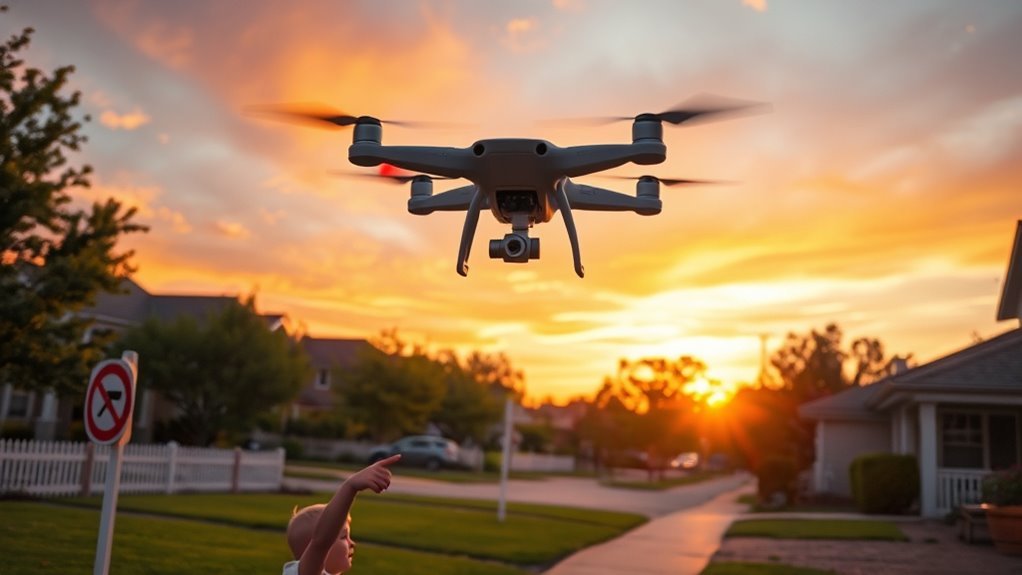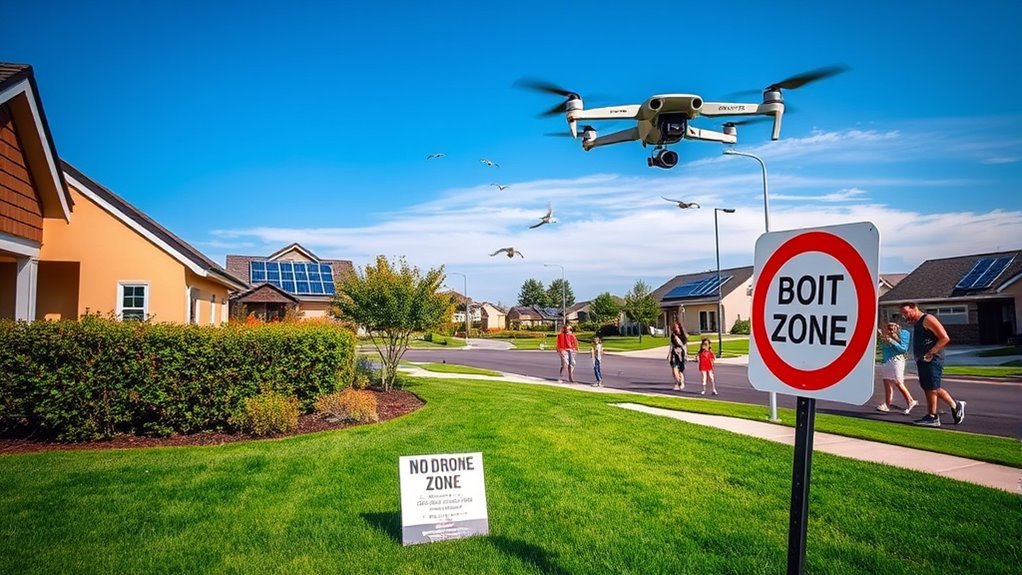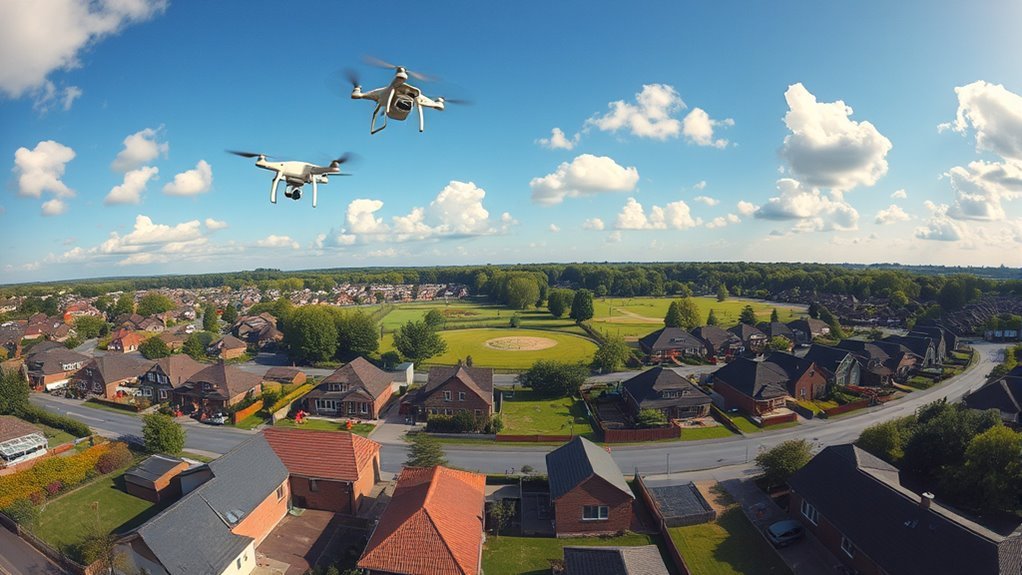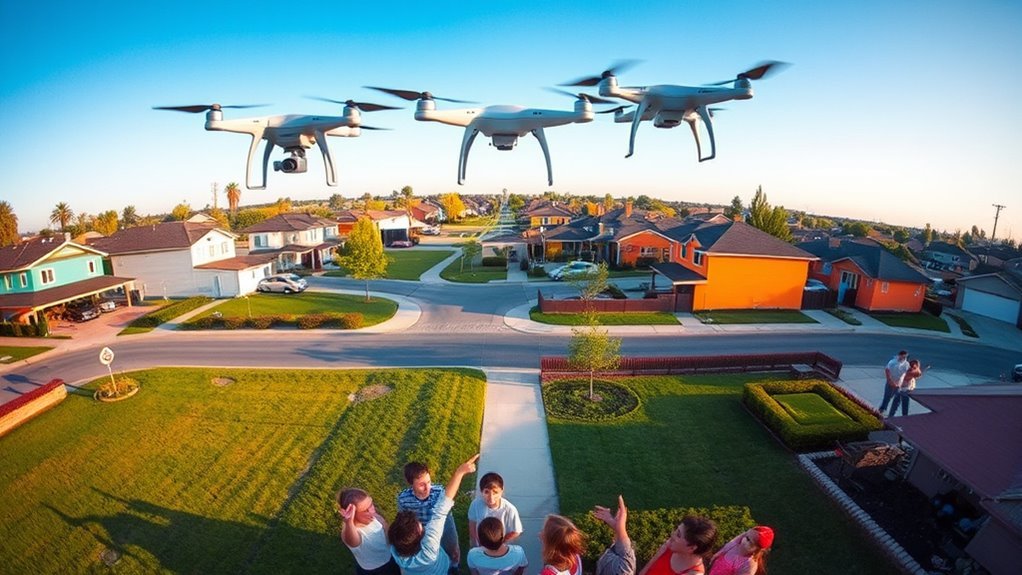To fly a drone in your neighborhood, you’ve got to follow FAA guidelines and check local regulations. Register your drone if it weighs over 0.55 pounds and maintain visual line of sight. Stay below 400 feet and avoid areas like schools and parks, which may have specific rules. Respect privacy by obtaining consent before flying over private properties. To guarantee compliance and safety, know the full scope of regulations you need to abide by.
Understanding Drone Regulations

When you fly a drone, understanding the regulations that govern its use is essential to ensuring safety and compliance. Familiarizing yourself with local laws around drone technology helps protect your freedom to operate while respecting others. You’ll want to engage with your community, as awareness of neighborhood rules fosters cooperation and reduces conflicts. Many areas impose restrictions on flight zones, altitude limits, and privacy standards. By staying informed about these regulations, you can enjoy your drone while minimizing risks. Engaging with local authorities can also enhance your knowledge and help shape community standards, ensuring everyone benefits from this innovative technology. It is crucial to be aware of restricted zones to avoid potential penalties and ensure safe drone operation. Additionally, understanding federal oversight can help you navigate the complexities of drone use while respecting others’ rights and freedoms. Embrace your right to fly responsibly and contribute positively to your surroundings.
Federal Aviation Administration (FAA) Guidelines

To guarantee safe and compliant drone operations, it’s crucial to adhere to the Federal Aviation Administration (FAA) guidelines. The FAA classifies drones into various categories based on weight and intended use, influencing your operational requirements. If you’re flying a recreational drone, you must register it if it weighs over 0.55 pounds. Always keep your drone within visual line of sight and below 400 feet. Additionally, avoid flying near airports or over crowds. Non-compliance can result in FAA enforcement actions, including fines or restrictions. By understanding these classifications and regulations, you’ll make certain you’re flying responsibly while enjoying your freedom in the skies. Embrace your passion for drone flying, but do so within the framework established by the FAA.
Local and State Laws

When flying your drone, it’s essential to understand that local regulations may differ greatly from federal guidelines. Each state can impose its own specific rules, affecting where and how you can operate your drone. Familiarizing yourself with these laws guarantees you’re compliant and helps avoid potential fines or legal issues.
Understanding Local Regulations
Although flying a drone can be an exhilarating experience, understanding local regulations is essential to guarantee compliance and safety. Many neighborhoods impose specific rules regarding drone usage, often influenced by community awareness and the desire for neighborhood engagement. Before you take to the skies, check local ordinances that might restrict flying near schools, parks, or residential areas. You’ll also want to be mindful of privacy concerns; recording in someone’s backyard could lead to conflicts. Engaging with your neighbors about your drone activities fosters understanding and minimizes disputes. Always stay informed on any changes to local laws, as they can vary greatly from one area to another, ensuring your freedom to fly without hindrance.
State-Specific Guidelines
While you might be familiar with general drone regulations, it’s vital to explore state-specific guidelines, as they can impose additional requirements or restrictions. Each state has unique laws that govern drone use, often addressing privacy concerns, airspace restrictions, and where you can fly. For instance, some states may prohibit flying over private property without permission. It’s also important to understand community guidelines, which may vary even within the same state. These local rules can dictate everything from flight times to designated flying areas. Always check your state laws and local regulations before operating your drone to confirm you respect both your freedom and your neighbors’ rights. Staying informed helps you enjoy your drone experience without legal complications.
Altitude Restrictions
Understanding altitude restrictions is crucial for safe drone operation, especially since flying above designated limits can lead to serious legal consequences. The Federal Aviation Administration (FAA) typically sets the maximum drone height at 400 feet above ground level in uncontrolled airspace. If you fly higher than this, you risk interfering with manned aircraft, which could result in fines or other penalties. Additionally, always check local regulations, as some areas may impose stricter altitude limits. To maintain your freedom to fly, adhere to these altitude limits and be aware of your surroundings. Respecting these guidelines not only guarantees your safety but also promotes responsible drone use within your neighborhood. Stay informed, and enjoy exploring the skies responsibly!
No-Fly Zones
Before you take to the skies with your drone, it’s essential to be aware of no-fly zones, as flying in these areas can lead to significant legal repercussions. No-fly zones are established to protect sensitive locations, such as airports, military bases, and certain public venues. Understanding drone technology is important for maneuvering these restrictions. You must check local regulations and use apps designed to highlight no-fly zones in your area. Community awareness plays a key role, too; respect the boundaries set to guarantee safety for everyone. Ignoring these rules not only risks penalties but can also jeopardize the freedom you seek to enjoy while flying. Stay informed, stay safe, and keep your flights within legal limits.
Privacy Considerations
As you prepare to fly your drone, it is crucial to take into account the privacy of others, since violating personal privacy can lead to serious consequences. Respecting your neighbors’ privacy not only fosters good relations but also keeps you compliant with regulations. Here are some key considerations:
Consider the privacy of others when flying your drone to ensure good relations and compliance with regulations.
- Obtain Neighbor Consent: Always ask your neighbors for permission if you’ll be flying over their property.
- Avoid Drone Surveillance: Don’t use your drone to capture images or videos of private spaces without consent.
- Stay Above Public Spaces: Make sure you’re flying in areas where the public has an expectation of privacy.
- Understand Local Laws: Familiarize yourself with local laws regarding aerial privacy and surveillance to avoid legal issues.
Respecting these privacy considerations keeps your drone activities enjoyable and lawful.
Drone Registration Requirements
In many countries, including the United States, registering your drone is a legal requirement if it weighs more than 0.55 pounds (250 grams). The drone registration process typically involves providing your details online, including your name, address, and email. Once completed, you’ll receive a unique identification number to display on your drone, ensuring compliance with regulations.
The drone registration benefits include easier identification in case of lost or stolen drones and a reduced chance of facing hefty fines. Additionally, being registered can enhance your credibility as a responsible operator, fostering trust within your community. Embracing this requirement not only helps you enjoy the freedom of flying but also promotes safety and accountability in the skies.
Safety Tips for Flying in Residential Areas
Flying a drone in residential areas requires careful consideration of safety protocols to secure the well-being of both operators and the community. To guarantee responsible flying, keep these safety tips in mind:
- Maintain a safe distance from people and property to minimize risk and respect privacy.
- Fly at a low altitude to avoid potential hazards and reduce noise disturbances.
- Stay aware of your surroundings, watching for pedestrians, pets, and other aircraft to promote community awareness.
- Check local regulations before flying, as restrictions may vary by neighborhood and can impact your flight plans. Additionally, be mindful of no-fly zone compliance, as certain areas may have specific restrictions on drone operations.
Reporting Violations and Seeking Permission
When you witness a violation of drone regulations, it’s essential to report the incident to local authorities promptly. Additionally, make certain you obtain all necessary permits before flying in restricted areas to avoid legal repercussions. Understanding these processes not only keeps you compliant but also contributes to the safety of the community.
Reporting Local Incidents
Although understanding the rules of drone operation is essential, knowing how to report local incidents is equally important for maintaining safety and compliance. If you observe any violations in your neighborhood, follow these steps to report them effectively:
- Contact Local Authorities: Reach out to your local law enforcement or designated drone regulatory body.
- Document the Incident: Take notes or photos of the violation, including time, location, and any identifiable drone information.
- Inform Your Neighborhood Watch: Share your findings with your neighborhood watch group to keep your community informed about safety concerns.
- Refer to Community Guidelines: Always check your neighborhood’s specific community guidelines regarding drone use to ascertain you’re abiding by local regulations.
Staying vigilant helps maintain the freedom and safety of your neighborhood.
Obtaining Necessary Permits
Before you take to the skies, it’s crucial to secure the necessary permits for drone operation in your area. Each jurisdiction has different regulations, so you’ll need to submit a permit application, which often includes permit fees. Failing to obtain these permits can lead to fines and restrictions on your flying freedom.
| Permit Type | Permit Fees |
|---|---|
| Commercial Drone Use | $150 |
| Recreational Use | $50 |
| Event-Specific | $100 |
Make sure to familiarize yourself with local laws, as they can vary greatly. Seek permission from property owners if you plan to fly over private land, ensuring you respect community boundaries and enjoy your aerial experience responsibly.
Frequently Asked Questions
How Can I Find Out My Neighbor’s Drone Flying Schedule?
To catch the buzz on your neighbor’s drone flying schedule, consider drone tracking apps. Pair that with open neighborhood communication, and you’re bound to discover their aerial adventures, ensuring you both enjoy the skies freely.
What Should I Do if a Drone Flies Over My Property?
If a drone flies over your property, consider documenting the incident. You might address any drone privacy concerns with the owner, emphasizing your property rights. Research local regulations to understand your options and protections better.
Can I Fly a Drone During Community Events or Festivals?
Before flying a drone at community events, you’ll need to check local drone regulations and obtain necessary event permissions. It’s essential to guarantee compliance so you can enjoy your freedom without legal complications.
Are There Specific Times When Drone Flying Is Prohibited?
You might think flying a drone’s always free, but there’re drone noise regulations and nighttime restrictions. Check local laws; certain times could have limitations, especially near residential areas or events. Always prioritize community peace and safety.
How Do I Communicate With Drone Operators in My Area?
To communicate with drone operators in your area, consider establishing a friendly dialogue. Share community guidelines and drone etiquette, ensuring everyone’s aware of flying times and locations, fostering respect and freedom for all involved.

